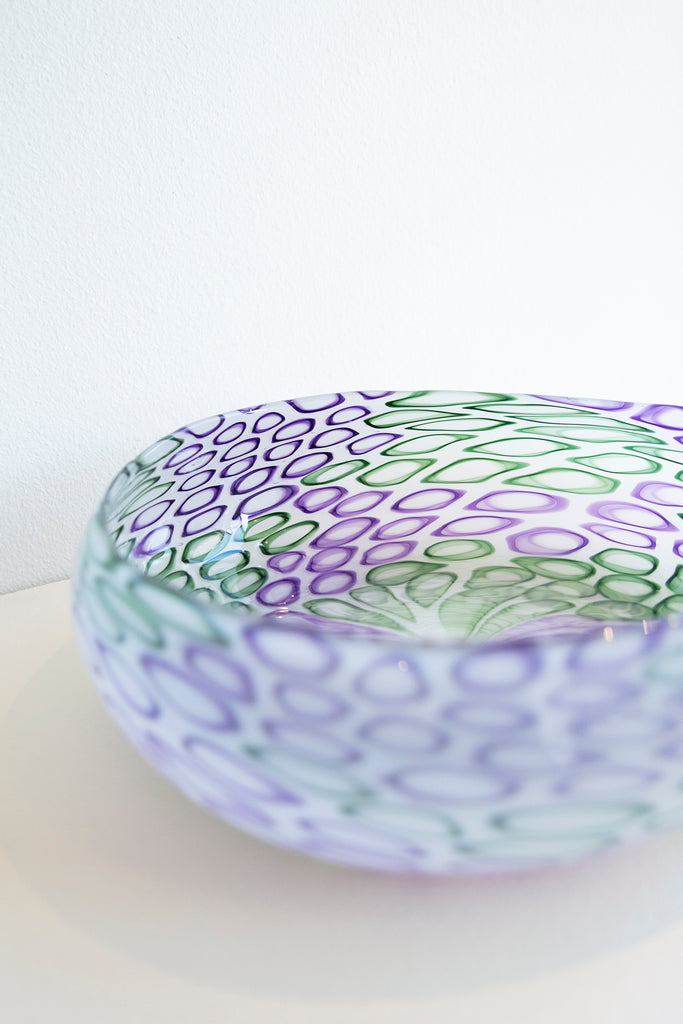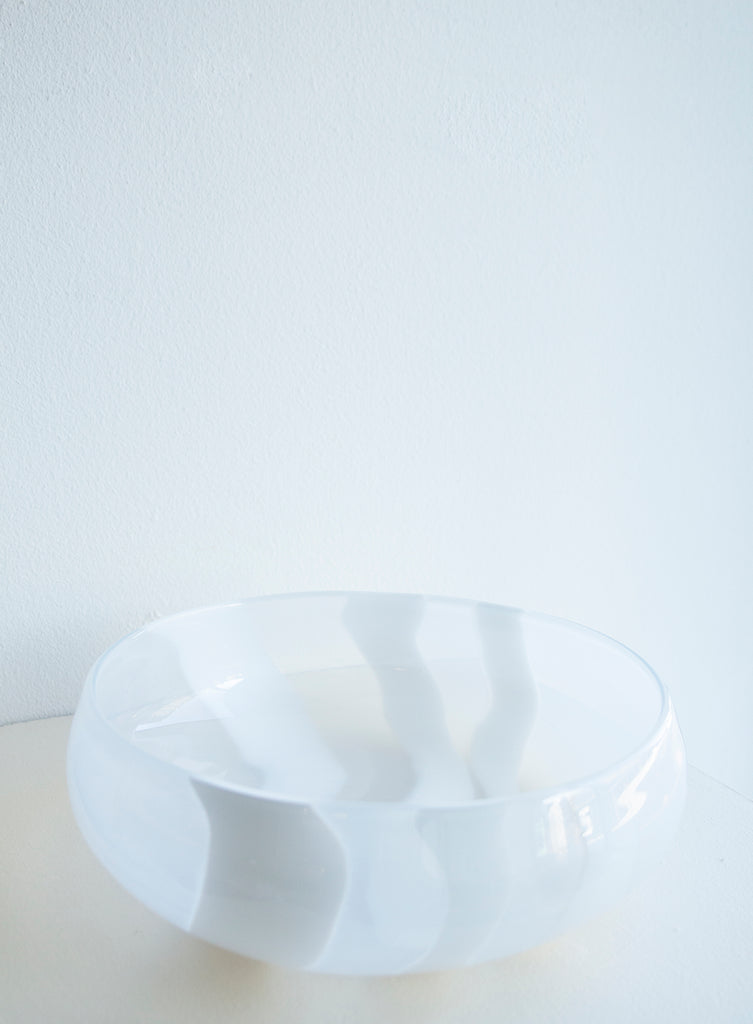Kari Håkonsen's earliest memory of creating is when, as a child, she made small bowls and dishes from clay from the bathing area by the river, which she left to dry in the sun and later painted. Today she makes objects in glass, a material she values for, among other things, its optical effects, and has prepared a series of bowls inspired by the suffragette's colors for the exhibition "8 Prints".
What kind of work do you create?
I am a glassblower and glass artist and create everything from functional utility items to unique art objects.
What is your earliest memory related to art, or to creating something?
I can remember that as a child I dug up clay at our swimming area by the stream. From this I made small bowls and dishes which I dried in the sun and later painted with water colours.
When in life did you first learn about your field of work? What brought you there?
Handicrafts became a real option for me when I started at the Statens lærhøgskole in shaping at Blaker. Through his studies there, working with art became increasingly attainable. I discovered Norwegian glass artists in the same period and curiosity about the material was created. Then I started an education to become a glass artist. Primarily with schooling in Sweden and England, but also periods of work in New Zealand, in Denmark and not least in industry here at home were important.

What is the best advice you have received?
"Move closer to one of the families." When, as a mother of young children, I and my husband were going to buy a house and the big question was where we were going to live, a bright mind said that it would be a good idea to move closer to family. Simply because then there would be help to get. We followed this advice and it was to the great joy and benefit of all parties, us, the children and the grandparents. We moved to Tjura in Hedmark, close enough to Oslo to be able to maintain contacts there, but far enough away that it was possible to live comfortably without it costing us everything we had. All this gave me peace of mind to be able to develop as an artist.
What is your relationship with the various materials you work with?
I only work with glass. This material has been all-consuming for me since our first meeting in 1992. Glass is immediate, you get quick answers, it is technically challenging, beautiful, it can be both transparent and opaque and, not least, it has optical effects. I get inspiration from working with the material. But occasionally I can feel that I miss the slower process I found when working in other materials, e.g. clay, wood or textile.
"Glass is immediate, you get quick answers, it is technically challenging, beautiful, it can be both transparent and opaque and, not least, it has optical effects."

Tell us a little about your workplace!
I have my workplace at Klart glass, which I run together with Vidar Koksvik. Here I fulfill many functions, not only the creative one, but also what concerns the operation and organization. Klart glass has two workshops/glass huts, one at Tjura in the former Hedmark county and one at Bærums Verk outside Oslo. In both places there is also a gallery and shop. We are a total of five employees in Klart glass. We produce utility glass, designed by Vidar and myself, for sale. A large part of our everyday work also goes to the development and production of unique objects for exhibitions and to decorate both private and public spaces.
What is the most challenging thing about being your own boss?
Being your own boss has both advantages and disadvantages. You have a freedom and independence that not many workers have. At the same time, no one tells you what needs to be done at all times, you have to be your own driving force. But perhaps the most challenging thing is to give yourself time off.
What motivates you?
Time pressure and deadline.
"Working with the material will always give me some form of inspiration and eventually also new ideas."

Do you have any tricks or techniques that never fail if you need inspiration or to break out of routines?
My only trick when I lack inspiration is to get out into the workshop and start working. It doesn't matter what I do when I'm finally in the workshop. Working with the material will always give me some form of inspiration and eventually also new ideas.
"I have been inspired by the colors that became the symbol of the suffragettes: white for purity, purple for loyalty and self-respect and green for hope and new life."
Tell us a little about the items you are exhibiting in this year's exhibition.
For the exhibition "8 imprints", I have tried to think about what 8 March symbolizes in our time. Women's Day, which many see as a day of celebration, was originally a day of struggle. We say happy birthday to all women. Here in our country, it may seem like a day when women can fill with important content for themselves. A cozy day? Or is it still relevant to fight a battle? Last year, extra people took the train on 8 March. A right that women in Norway saw as a matter of course in 2018 had been threatened and we mobilized and marked. At the end of the 19th century and the beginning of the 20th century, many women mobilized for a right we in any case take for granted in our day and in our part of the world: the right to vote. The suffragettes in Great Britain fought for independence, their own guardianship, the right to vote and for women to be taken seriously as thinking individuals. This with opposition from large parts of society, even from other women. I have been inspired by the colors that became the symbol of the suffragettes: white for purity, purple for loyalty and self-respect and green for hope and new life. Based on these colours, I have developed a series of bowls. I also use the glass's transparent and opaque qualities actively and consciously in the design of the bowls. " Z " I took the rare and characteristic letter that gives the series its name from the name of a pioneering woman in Norwegian glass history, namely Benny Motzfeldt. I discovered Benny Motzfeldt when I worked at Randsfjord glass works in the 90s. Her 3-year involvement there in the early 70s still influenced both the workers and the production, and her designs were still in the collection. The way Benny Motzfeldt experimented with glass and how she stretched the boundaries of the material has always been a great inspiration to me.
What kind of imprint or representation of yourself have you left in the works for this exhibition?
I think my relationship with good form is expressed in everything I do, whether it is functional objects or sculptural. Making a good shape in glass freehand is an exercise that requires its woman and bowl shapes in particular, and perhaps that is precisely why I have "pursued" this type of shape since the beginning. Succeeding in a bowl is one of the funnest things I know, technically challenging and incredibly fun. That's how it's always been. It should look and feel that it is made of glass. I also enjoy the experimentation that working on this project has forced me into, challenging and frustrating just like a working day can be at its best.
About Kari Håkonsen
Kari Håkonsen is an artisan and works with glass in a wide range of techniques. In the borderland between art, craft and design, Håkonsen works with sculptural and functional objects in both blown and freehand shaped glass. Håkonsen makes sculptural art glass and glass for decoration in addition to functional objects such as wine glasses, bowls and vases. Together with colleague and spouse Vidar Koksvik, Håkonsen makes up half of Klart glass. In the workshop, they blow and design both their own glass work and glass for others, and creative workshop collaboration has made it possible to explore new areas and create innovative glass art. As a glass artist, Håkonsen is concerned with the artistic, material and technical possibilities inherent in glass. During her career, she has gone from exploring the massive, heavy and optical glass to the fragile, thin and light glass stretched to the extreme limit of the material's endurance limit.




